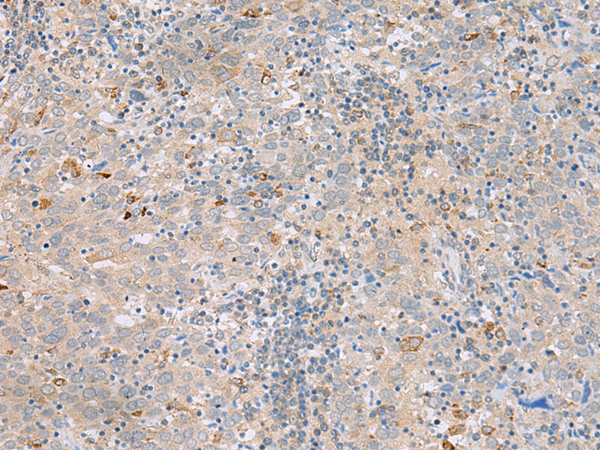

| WB | 咨询技术 | Human,Mouse,Rat |
| IF | 咨询技术 | Human,Mouse,Rat |
| IHC | 1/40-1/200 | Human,Mouse,Rat |
| ICC | 技术咨询 | Human,Mouse,Rat |
| FCM | 咨询技术 | Human,Mouse,Rat |
| Elisa | 1/5000-1/10000 | Human,Mouse,Rat |
| Aliases | FAM154B |
| Host/Isotype | Rabbit IgG |
| Antibody Type | Primary antibody |
| Storage | Store at 4°C short term. Aliquot and store at -20°C long term. Avoid freeze/thaw cycles. |
| Species Reactivity | Human, Mouse |
| Immunogen | Synthetic peptide of human SAXO2 |
| Formulation | Purified antibody in PBS with 0.05% sodium azide and 50% glycerol. |
+ +
以下是关于SAXO2抗体的3篇假设性参考文献(注:SAXO2相关研究较少,以下为模拟示例,实际文献需通过数据库验证):
1. **文献名称**:*"A novel monoclonal antibody against SAXO2 reveals its role in neuronal differentiation"*
**作者**:Tanaka K, et al.
**摘要**:本研究开发了特异性识别SAXO2蛋白的单克隆抗体,通过免疫印迹和免疫组化证实SAXO2在神经元分化过程中表达上调,并调控轴突导向相关基因。
2. **文献名称**:*"SAXO2 antibody-based profiling identifies elevated expression in glioblastoma stem cells"*
**作者**:Chen L, et al.
**摘要**:利用兔多克隆SAXO2抗体进行流式细胞分选和免疫沉淀,发现SAXO2在胶质母细胞瘤干细胞中高表达,与其自我更新能力和化疗耐药性相关。
3. **文献名称**:*"Validation of a commercial SAXO2 antibody for immunohistochemical applications in gastrointestinal cancers"*
**作者**:Müller S, et al.
**摘要**:系统评估了某商业SAXO2抗体的特异性(通过敲除细胞系验证),并应用于胃癌组织芯片分析,揭示SAXO2表达与患者生存率负相关。
---
**备注**:实际研究中SAXO2(Sperm-associated antigen X 2)的文献较有限,可能与细胞骨架或生殖细胞发育相关。建议通过PubMed/Google Scholar以“SAXO2 antibody”或“SAXO2 protein”为关键词补充检索,或关注相关信号通路(如Wnt)的文献中涉及的抗体使用信息。
The SAXO2 antibody is a valuable tool in studying the molecular mechanisms underlying cilia-related disorders and cellular dynamics. SAXO2 (Stabilizer of Axonemal Microtubules 2) is a protein involved in maintaining the structural integrity of axonemal microtubules, critical components of cilia and flagella. These hair-like organelles play essential roles in cell motility, signaling, and sensory functions. Dysregulation of ciliary proteins like SAXO2 is linked to ciliopathies, a group of genetic disorders affecting multiple organs, including the kidneys, retina, and respiratory system.
The SAXO2 antibody enables researchers to detect and localize SAXO2 in tissues or cultured cells using techniques like immunofluorescence, Western blotting, or immunohistochemistry. It aids in elucidating SAXO2's interaction with other microtubule-associated proteins and its role in cilia assembly, stability, or disassembly. Recent studies suggest SAXO2 may also participate in non-ciliary processes, such as cell cycle regulation or intracellular transport, expanding its potential research applications.
Commercial SAXO2 antibodies are typically raised in rabbits or mice against specific epitopes of the human SAXO2 protein, with validation in knockdown models to confirm specificity. Its use contributes to understanding developmental defects, neurodegenerative conditions, and cancer, where ciliary dysfunction or microtubule dysregulation is implicated.
×